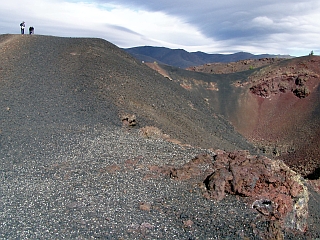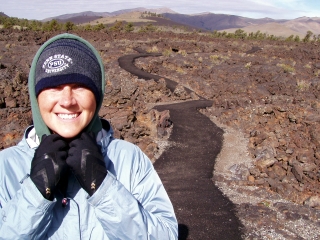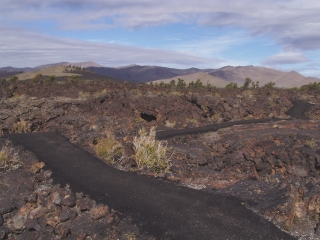NPS Website; Local Website
 WHAT IS IT?
WHAT IS IT?Remnants of over 60 recent lava flows, the latest of which occurred only 2,000 years ago.
BEAUTY (5/10)
The landscape at Craters of the Moon NM certainly is distinct, but our 5 Rating might be a stretch. The subtleties were lost on us; we thought it looked like a gravel pit. The dark, fragile and sharp rocks decorate every flat horizon while cinder cones pop up every now and then. Sinewy curves run through the rocks, remnants of the fiery lava rivers that carved the land.
HISTORICAL INTEREST (3/10)
Not much. A foolish band of Oregon Trailers once tried to detour through the Craters of the Moon but rethought their route through the lava fields after their wagons and their feet were severely damaged.
CROWDS (4/10)
The crowds did not bother us; they were all smiles. We had problems with the small Visitor’s Center and its stuffy Museum. The Museum was our only chance to learn anything about the weird and foreign landscape we were in, but we had few occasions to read the exhibits. Too many people in too small a place. Michael was especially disappointed not to take in the 70’s-era diorama explaining the pathway of the hot spot that now sits underneath Yellowstone National Park and created the Rift Zone of Craters of the Moon NM. After 15 minutes of trying to force his way through a phalanx of well-behaved 13-year olds receiving instruction from the Site’s one Ranger, we decided to start hiking.
EASE OF USE/ACCESS (2/5)
Craters of the Moon NM is not as remote as Idaho’s five other National Parks Sites, but it’s close. U.S. Route 93 provides access from the west and U.S. Routes 20 and 26 from the east. The Site is 90-100 miles from the Gem State cities of Twin Falls, Idaho Falls and Pocatello. Craters of the Moon NM also falls along the scenic path that leads from Boise to Yellowstone NP and is nearby to the resort town of Sun Valley and the Sawtooth Mountains.
The few accessible parts of the Site are very accessible. A newly paved seven-mile loop takes you to six different lava field overlooks. The overlooks and the trails that sprout from them are mostly paved or on boardwalks.
CONCESSIONS/BOOKSTORE (2/5)
We saw no books specific to the environment of the Site. The generic selection of bird and geology guidebooks was no different from the base stock at every other Park or at the Borders™ around the corner.
 COSTS (3/5)
COSTS (3/5)The Site costs $5 per car to enter. We believe entry is free with the National Parks Pass. No one was checking during our visit. The Park’s 51 campsites are absolutely free. The National Parks Guide stresses that you bring a sturdy ground cloth as you are camping in the middle of a lava bed field. We saw a few pitched tents and would have camped had it not been so cold. The campground looked really nice.
RANGER/GUIDE TO TOURIST RATIO (1/5)
There was only one Ranger and one volunteer in the smallish Visitor Center to deal with over 35 tourists, including a group of 20 middle school students. There were no posted Ranger talks or guided hikes, they only happen from Memorial Day through Labor Day. We would have appreciated the Site more had we been able to both learn from and question a Ranger. Given the large amounts of visitors we encountered in mid-September, the NPS should heighten the Ranger presence throughout the months of May and September.
TOURS/CLASSES (2/10)
There were no guided tours of the lava beds. The mimeographed self-guided tour pamphlets were $0.50 and available only at the Visitor Center and not at the trailheads. Especially vexing since the 7-mile car tour is one-way. We had little idea what we were looking at. Troubling, since Craters of the Moon has been described, the free Park Pamphlet tells us, as “an outdoor museum of volcanism” and “the strangest 75 square miles on the North American continent”.
The Visitor’s Center introductory video is helpful but not nearly enough. The remainder of the museum had limited exhibits that looked to be from the Mission ’66-era that we could not even read because of the large crowds.
FUN (3/10)
There is not a lot to do here. The fragile rock restricts access to all but the few paved and permissible trails. You see the same tourists at every overlook and trail. By the end of your stay you know the make and model car of everyone you have said hello to.
 WOULD WE RECOMMEND? (4/10)
WOULD WE RECOMMEND? (4/10)We left with the feeling that we had arrived after the party was over. Instead of oozing lava, there were just flat fields of rock. Since the lava flows occur every two thousand or so years, the Great Rift field under the Craters of the Moon is due. The fun should happen again within the next few hundred years. Keep your eyes open, this place will soon be alive again.
TOTAL 29/80
www.usa-c2c.com
© 2004-06